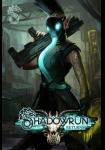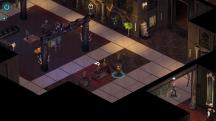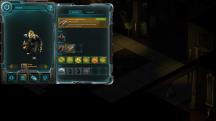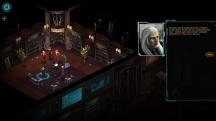Shadowrun Returns Review
Shadowrun! I have such great memories of playing P&P Shadowrun, a game where cyberpunk meets fantasy: Shamans performing their rites in the urban jungle. Troll bouncers in the local club. Breaking into the headquarters of a megacorporation... Bad idea... Shooting it out with Lone Star guards... Outsmarting the dragon that *runs* the megacorp... Finding that we have been outsmarted instead... Blowing stuff up... Hiding in the shadows... Decking to cover our tracks... Good times! While we took our fantasy P&P quite seriously, our Shadowrun sessions were wild, whacky fun. With fond memories however, come expectations.
Expectations. Expectations are a weird thing, aren't they? Nothing like waiting for a great game, greedily sucking up all the info you can get, watching the videos, reading the interviews, and slowly feeling the excitement build to fever pitch as the release date draws near! And of course, nothing more dangerous - believing the hype, building a dream-game in your head, only to be hit by a less than glorious reality. Shadowrun Returns was loaded with expectations for many of us: Shadowrun! The SNES game! Dreamcast game! (none of which I have played, but others seem to remember them fondly) Turn based! DRM free! Kickstarter super-success! The creator of Shadowrun himself at the helm! Faced with such a clutter of expectations, how did the game survive the clash with reality?
The looks and the gears
From the get go, Shadowrun makes a very solid appearance. The game was largely stable for me. I noticed a few minor bugs, but none were game breaking. While the 2D isometric approach (with a fixed, but zoomable camera) itself may be oldschool, the artwork, GUI design, and programming is professional, high res, colorful and beats most of the older games it is modeled after. The chosen art style has been the subject of some controversy, I believe. It has been described as cartoony, but that may be somewhat imprecise. It's a painterly style more reminiscent to sci-fi cover art or indeed the original rule book illustrations (google for shadowrun rule book art to see what I mean) than most comics - no flat coloring and no cell-shading. The theme is nicely and consistently realized, from the cyber-styled UI, over the awesome portrait art, all the way to the colorful, neon-lighted world art. I have to admit I really enjoyed the latter, in particular for the scenes in the barrens and other urban locations. I spent minutes just checking out all the nice little details in these scenes: graffity, shop names, random NPCs, it all breathes the spirit of shadowrun. These levels are not built from lovelessly slapped together tiles, but from many, many hand painted props, tile pieces an decals.
Not that all is perfect: Not all scenes are quite as nicely detailed, not all work equally well, but overall Shadowrun Returns has a simple but attractive look. Some levels suffer a little from "cratetitis", an overabundance of strewn-about crates and other props with no purpose other than to make the level look more busy or serve as cover. While the sparse addition of animated set pieces adds some life to the scenes, there is one that really irritated me: I don't know what animates those leaves of paper that occasionally blow over the sidewalks in town, but I would propose demonic possession - it sure as hell can't be wind! The game may not be as gritty and realistic as some would have liked, but I think you can't fault it for taking a clear artistic vision, and following through with it. It seems clear to me that the presentation is where a good part of the KS budget went, and it shows, if you care to look. With regards to animations however, the game is far less ambitious; there is e.g. only a single, pretty abstract "use" animation, no matter what you are actually doing.
The soundtrack is a collection of synthesizer-driven techno-pop tracks, that fit the cyberpunk theme well. I must say however that I was surprised that there were so many tracks. The music is rather similar throughout and serves more as a fitting backdrop than ever trying to get your attention. Sounds are similarly working well without being especially noteworthy.
Gameplay
The awakening: Character creation and progression
As usual, you start the game by creating your character, making a choice among human and metahuman races (dwarf, elf, orc & troll) of the shadowrun universe, and a class, here called "Archetype". You can be a street samurai (a fighter class), a decker (hacker), a rigger (drone controller) a physical adept (magically augmented fighter), or a shaman (conjurer).
The archetype gets you your starting stats and abilities, but the system is actually entirely open with regards to character development, which is based on stat improvements and purchases of equipment and magical abilities form vendors. Your stats consist of attributes and skills, and both can be increased from the same pool of skill points (called Karma here). The skill point cost to increase a stat is equal to the current level of the stat + 1, so getting to higher ranks becomes increasingly expensive. Attributes have a direct impact on gameplay elements and are used in dialog, but they also set the maximum limit for a subset of skills associated with that attribute. In contrast, skills govern specific character capabilities like weapon use, different magical schools, spirit control, drone control, etc. Every few levels of a skill or attribute, you will unlock a predefined perk, unlocking e.g. a more powerful level of magic spells, additional inventory or magic slots, etc.
In Shadowrun Returns you play your main character who may be alone or accompanied by a variable party of up to three additional characters, plus combat additions like conjured spirits or drones. There are a couple of story-related NPCs that will occasionally join you on your adventures, but for most of the larger missions you will be able to hire your team freely, choosing from a roster of mercenary shadowrunners. Hiring them costs money, and of course the better guys charge more. The system may remind you a little of Jagged Alliance, and it allows you to experiment with different character archetypes weapons and spell loadouts over the course of the game - which is nice, but at the same time somewhat reduces the novelty of any replays with a different archetype you may have in mind. Hiring the right team can be very important - when I had to reload, hiring a better suited team was usually the key to success on the next attempt.
Exploring the shadows
Because I liked the look of the world, it just hurt the more that exploring it turned out to be so disappointing. Not only is the story and the sequence in which you visit the levels entirely linear, the levels themselves are linear as well. There are very few things to discover, and mostly your interaction with the world is limited to clicking on the few hotspots and interactive NPCs in the scene, all of which are further highlighted by symbols as you approach.
Often even the sequence in which you can talk to the NPCs or activate the hotspots is predetermined to some extent. For example, you may enter a room that only has a single usable element, a computer terminal. Only once you have used that terminal, and retrieved certain information, other hotpots in the room will become available, only after clicking all of them will you be able to progress further, etc.. I don't think I have ever played an RPG that seemed more afraid of losing control than this one. Occasionally you will encounter obstacles that allow a few different approaches to bypass them, but overall there is very limited opportunity to do anything creative in this game. While in real time mode you do not even have access to the skills of your companions.
When the going gets tough, the tough go shopping
Another RPG staple, looting, is only a very minor element as well - you may find the occasional credstick or piece of equipment on your missions, but those are both rare and at the same time trivial to find due to the symbols highlighting them. Instead, you generally rely on equipping yourself for your missions at vendors beforehand. At least, in contrast to pre-release rumors, there is an Inventory. It is split into a party stack which is only available when you are at your safe house (although you can send items you find there during missions) and each characters personal inventory. This inventory is small, you have a slot for armor, a few slots for weapons, and most critically only a very limited number of slots for consumables, amulets (consumable that allows shamans to summon spirits) and grenades, so you have to plan carefully what you want to take - on the other hand hired runners already come equipped with a basic kit, that will suffice for most runs. This system may sound limiting on paper but it actually works fine. It certainly fits the shadowrun spirit, which IIRC had the famous phrase in its rulebook: "When the going gets tough, the tough go shopping".
Unfortunately there are two aspects that really irked me about the inventory system: for one, there appears to be no way to redistribute inventory items between characters during the run, which would sometimes be useful. Secondly it seems that all equipment you assign to your party from your stack is gone after the mission, whether it was used or not.
Let's talk, chummer!
Consistent with the beautiful world design but timid approach to exploration, dialog is very nicely written and offers roleplaying flavor choices, but also results only rarely in actual consequences. Occasionally, additional options related to your skills, attributes or "Etiquette" perks will be available, that will usually result in a better or different outcome in a specific situation, but there is no major plot branching. Interaction with computers is usually also handled through the dialog interface, except when you actually engage in decking to enter the matrix. The writing of the dialog and scene descriptions per se, I would say plays in the premier league of video game writing. Shadowrun is a great setting for interesting seedy characters, and the dead man's switch campaign makes excellent use of it.
When the drek hits the fan...
Combat is turn-based with a simple action point system - one AP allows you to move a certain distance, fire a weapon, or cast a simple spell. Other actions, such as some spells, throwing grenades, etc., may cost 2 or more AP. Since the Shadowrun universe mixes high-tech weaponry, melee-oriented street samurai and magic, there is a nice array of different attacks, buffs and debuffs available to the player between the different types of runners. Each individual runner may not have that many different options each round, but with a group of four that matters relatively little. Paying attention to
positioning is encouraged by a simple cover system that grants you a directional defense bonus. Using single-use amulets, Shamans may conjure spirits to aid them in battle transferring some, or all of their AP to the spirit in the process. Spirits, of which there are various kinds, each have their own set of attacks and spells. Interestingly spirits can escape control of the shaman (the more easily the longer you keep them or the more AP you give them), and turn against the group. The more technically inclined can instead control drones, which work in a similar way to spirits. In some scenarios you may need to jack into the matrix to reach your objective, and the game will switch back and forth between the real world fighting and the activity in the matrix. This all adds up to a pretty neat TB combat experience, when you finally encounter some challenging and interestingly designed fights in the late parts of the game. In the early stages, the encounters are generally rather easy, and as a result a bit boring. The difficulty curve may vary considerably based on your character choice and choice of companions. My own experience is based on playing a shaman, rather a weak class. Playing a Street Samurai will probably give you a far more powerful character in the late game, and therefore less of a challenge.
The generally rather forgiving combat difficulty may however be fortunate given the checkpoint save system that generally means you have to replay an entire level if you fail a mission (OK, they are usually short, but it can be a drag to go through all conversations and hotspot clicking and minor battles again). This much debated feature still leaves me scratching my head. Checkpoint save systems can be a valid design decision, enhancing the sense of tension and encouraging players to run with decisions they have made. But in a game with so little challenge and so few meaningful choices, does that really apply? And when you actually fail to win a fight, your best course of action is usually to hire a different team - and THAT means rewinding to the start of the scene in the hub and going through all the conversations there again... And not having at least a save on quit function is just a nuisance, especially since savepoints are not spaced evenly, time wise. Just when you really want to go to bed, you can be sure you'll be stuck in one of the rare really long levels. And considering the planned release on tablets, where mobile gamers are even more likely to have to leave the game when the train stops or the plane lands, it makes even less sense. In spite of what Harebrained said, I just can't buy that it would have been a major effort for any seasoned programmer to implement a save anywhere or at the very least a save on quit function, especially considering the simplicity of the levels. I think they simply went too far with their desire to simplify and streamline in this respect.
The shadows tell many stories...
The story of the "dead man's switch" itself starts as a film noir inspired detective story that I found rather appropriate and interesting as a Shadowrun story. You find yourself pretty down on your luck and with few friends in Seattle. Ironically, the one message that lights up on you comlink turns out to be from a dead person. A fellow runner you have worked with in the past informs you about the titular "dead man's switch" that he had set up on a hunch, triggering the message on his own death and leaving you with the tasks of finding the cause of your friends death and bringing those responsible to justice. Not that the guy was such a good friend, but with the promise of the nice sum of 100.000 Nuyen as a reward, you set out into the shadows. Of course, various surprises wait on the way, and soon you find yourself on the trail of not one but several grizzly murders. The story is organized into various shorter missions that will lead you to different locations. A seedy shadowrunner bar will soon become your home away from home and serves as the "hub" location for the game, where you buy gear and hire shadowrunners for each new task. "Hub" goes in quotation marks because you don't have a choice regarding the missions, the sequence is linear. Nevertheless, it is here that you will meet some of the game's most memorable NPCs, and it's a good design that allows you to feel more connected to the game-world.
Late in the game the story spins into a more fantastic and (to me) slightly cheesy direction, which unfortunately forgoes the more personal and dirty down-to-earth feeling of the earlier parts for high adventure. The game dutifully touches Shadowrun staples such as megacorporate power, down-and-out urban sprawl, gang warfare, etc. Maybe a bit cliché if you already know Shadowrun, but appreciated in a game that seeks to revive the IP and to introduce it also to new players. A little worse is that it positively wallows in the damsel in distress trope, several times over. I wish we could move beyond that.
The ending uses one of the games strengths, dialog and writing to wraps things up by giving you a chance to discuss various things with some of the main characters you have met during your adventure, and some final remarks about future developments (and a tiny bit of foreshadowing for the Berlin campaign). It's nicely done.
Overall it's an entertaining tale, although not a great one. The shortness and linearity makes it easy to follow. But the point remains that the game keeps you on an excessively short leash throughout, and for that reason it often felt more like a point-and-click adventure with RPG elements than an actual RPG. If you don't mind to simply be told a story in the guise of a RPG, you will be fine - if player agency, choice and consequence, and exploration are a prerequisite for enjoyment for you, you will not find nearly enough of it here to make you happy.
I can change the world? Wiz!
The dead man's switch campaign however is only one aspect to consider with this release. The other is, obviously, the campaign editor, that was from the beginning an integral part of the Kickstarter campaign. The editor is a complex but still relatively user friendly program that should be fairly quick to learn for those with an interest, certainly if you have fiddled with other game editors before. Maps are put together from tiles and props and light sources using an intuitive drag and drop interface. All the material from the campaign and some extras are available, but you can also paint your own, e.g. in Photoshop, or download resources created by other users from the steam workshop. Interaction is created through a system of triggers, variables, items and functions that are likewise created in a simple, menu driven way. However the number of elements is quite large and will take some time to explore before you can create really interesting interactions. An actual scripting language does not seem to be involved, but there appears to be enough meat to the system to be quite creative.
Harebrained had the good sense to release some pretty helpful tutorials, and set up a wiki, and the community is already contributing additional documentation. The editor seems capable of rapidly putting together adventures, and the modding scene indeed seems to take off, with the Steam Workshop growing from three to seven pages of interesting sounding modules (mostly still in development, of course) and resources during the time I spent playing and writing this review. Shadowrun unlimited for example promises a more open world with random runs, docwagon contracts, and other Shadowrun staples. The deep one provides an unofficial sequel that allows you to continue playing with your dead man's switch character. Return to Seattle is another campaign that promises to focus on contract work in an open world and random events. And there is much more and even more in the works. It remains to be seen whether highly ambitious mod projects like Shadowrun identity that tries to create modules based on all classic Shadowrun P&P source books will come to fruition, but I have little doubt that we will be seeing interesting content. There are limitations to this editor, but as in any mod community worth its salt, some people are already pushing the boundaries of what the editor can do, and of course we can hope that harebrained themselves will continue to support and add functionality to this tool. According to a recent update, even a revision of the savegame system is under consideration. The continued supply of new tutorials for the editor is also a good sign.
To clear up another rumor that was going around -no, user created content is not exclusive to Steam, you can install user created content manually - steam workshop is not required, just convenient. There is now also a Nexus site for Shadowrun Returns that should facilitate mod browsing outside of the Steam workshop.
Conclusions
My overall impression is that the project was really afraid to take any risks. It shows an almost metahuman level of control, a will to make smart business decisions: starting out small, avoiding feature creep, concentrating on essentials. All good advice to any startup indie game developer, I am sure. But as a result, when I think of words to describe this game, what comes to mind are words like solid, neat, groomed, polished, focused, controlled... ultimately: a little boring. It lacks passion. It's not the wild whacky fun that I remembered. To be clear: I don't consider Shadowrun Returns release campaign Dead man's switch a dud; it delivered 15-20 hours of linear story-driven fun (note: I am a slow player and including some reloads it took me over 25 hours, but most people seem to clock around 15 hours), good writing, solid RPG and combat mechanics. It is a short, limited, but polished game - on tablets it should even be a stand-out title in the RPG genre. It is not, however, a game that will really satisfy most hardcore CRPG fans. While the original campaign was certainly somewhat underwhelming to me in its excessive linearity, I on the other hand really appreciate that Harebrained made good on their Kickstarter promise of releasing a solid game editor. That is no small task, and not just a trivial little addition. That's a major project in itself. And the signs are good that we will get some fun content because of it.
I am still glad that Shadowrun has returned, and that finally there is a PC RPG based on the IP. Importantly, it comes with a tool for Gamemasters with hopefully more passion than Harebrained could muster for the initial release. I am optimistic we'll see fun stuff come out of the modding scene, or from future modules by harebrained. The recent delay of Harebrained Scheme's own Berlin DLC to allow for a more complex campaign is a good sign in that respect (although them planning an even shorter campaign initially isn't).
At the time of writing, a month after release, the game still holds a spot in the top 50 of the steam sales charts. So who knows, maybe it was wise for Harebrained Schemes to have played it safe and lived instead of crashing and burning in attempted glory like so many other RPG developers (R.I.P). But man, I still wish Shadowrun Returns would truly awaken: it needs to grow some tusks, horns, and hair on its chest, swell to twice the size and become a little meaner, if you know what I mean. Let the drek hit the fan, Harebrained! See you in Berlin, chummers.
For now, it gets 3 out of 5 stars: "a good game held back by obvious technical or design issues that limit the appeal."

Information about
Shadowrun ReturnsDeveloper: Harebrained Schemes
SP/MP: Single-player
Setting: Technofantasy
Genre: RPG
Combat: Turn-based
Play-time: Unknown
Voice-acting: Unknown
Regions & platforms
Internet
· Homepage
· Platform: PC
· Released: 2013-07-25
· Publisher: Harebrained Schemes
More information
Summary
Pros
- Solid RPG mechanics and TB combat
- Good writing and good story with memorable characters
- Finally an RPG in the Shadowrun setting on the PC
- Game editor released with the game
- Colorful, hand-painted 2D isometric look
Cons
- Excessively linear, little replay value
- Rather short campaign
- Limited and sometimes poor animation











